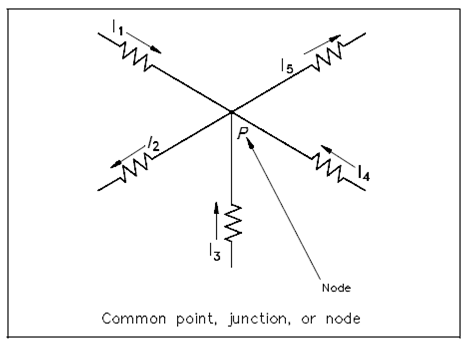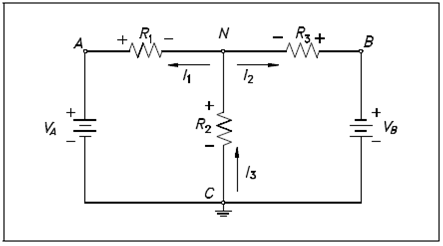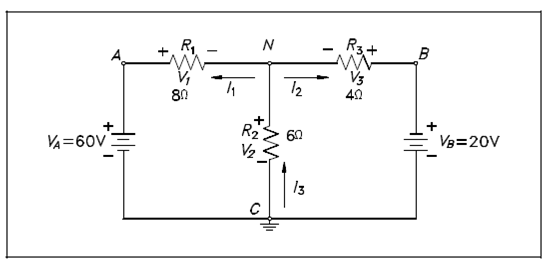Node Equations:
Kirchhoff's current law, as previously begin, says in which at any junction point in a circuit the current arriving is equal to the current leaving. Let we consider five currents entering and leaving a junction display as P in the Figure. This junction is also known a node.
Suppose that all currents entering the node are positive, and all currents that will leave the node are negative. Thus, I1, I3, and I4 are positive, and I2 and I5 are negative. Kirchhoff's Law also states that the sum of all the currents meeting at the node is zero. For Figure, Equation (2-19) represents this law mathematically.
I1 + I2 + I3 + I4 + I5 = 0 (2-19)

Figure: Node Point
Through solving node equations, we could calculate the unknown node voltages. For each node within a circuit we will assign a letter or number. Inside the Figure which is given below, A, B, C, and N are nodes, and N and C are principal nodes. Principal nodes are those nodes along with three or more connections. Node C will be our chosen reference node. VAC is the voltage among Nodes A and C; VBC is the voltage among Nodes B and C; and VNC is the voltage among Nodes N and C. We have already determined that all node voltages have a reference node; thus, we could substitute VA for VAC, VB for VBC and VN for VNC.

Figure: Circuit for Node Analysis
Suppose that loop currents I1 and I2 leave Node N, and that I3 enters Node N as like in the figure. From Kirchhoff's current law:
∑I=0
I1 + I2+ I3= 0
I3 = I1 + I2 (2-20)
By using Ohm's Law and solving for the current by every resistor we acquire the following.
I = VR/R where VR is the voltage across resistor, R.
I3 = VN/R2
I1 = VA - VN/R1
I2 = VB - VN/R3
Substitute these equations for I1, I2, and I3 into Kirchhoff's current equation (2-20) yields the following.
VN/R2 = VA - VN/R1 + VB - VN/R3
The circuit display in Figure could be solved for voltages and currents through using the node-voltage analysis.

Figure: Nodes - Voltage Analysis
First step, suppose direction of current flow display. Mark nodes A, B, C, and N, and mark the polarity across every resistor.
Second step, using Kirchhoff's current law at Node N, solve for VN.
I3 = I1 + I2
VN/R2 = VA - VN/R1 + VB - VN/R3
VN/6 = 60 - VN/8 + 20 - VN/4
Clear the fraction so which we have a general denominator:
4 VN = 3 (60 VN) + 6 (20 VN)
4 VN = 180 - 3 VN + 120 - 6 VN
13VN = 300
VN = 23.077
Third step, find out all voltage drops and currents.
V1 = VA + VN = 60 - 23.077 = 36.923 Volts
V2 = VN = 23.077 Volts
V3 = VB - VN = 20 - 23.077 = -3.077 Volts
The negative value for V3 shows that the current flow by R3 is opposite that that was supposed and that the polarity across R3 is reversed.
I1 = V1/R1 =36.923 V/ 8? =4.65 amps
I2 = V3/R3 =-3.077 V/ 4? =-0.769 amps
I3 = V2/R2 =23.077 V/ 6? =3.846 amps
The negative value for I3 displays in which the current flow by R3 is opposite that which was supposed.